| |
Grand
Chapiteau
Creations
POMP
DUCK
|
|
|

"A Restaurant Out of Control!"
|
"In 1999, Cirque du Soleil is staging seven shows on four continents: Alegría,
Quidam, Mystère, "O" , La Nouba, Saltimbanco, and Dralion. Last but not least is
the dinner show Pomp Duck and Circumstance."
Once again, I found myself scrolling through the Wayback Machine's glorious
archived version of Cirque du Soleil's old '90s website - a wonderful snapshot of a
time when Cirque was younger, smarter, and much, much smaller. Between the dated
GIFs and bright blue-and-yellow backdrops, I came across a sentence that gave me
pause: "Last but not least is the dinner show Pomp Duck and Circumstance."
For the millionth time, I found myself wondering, like so many Cirque fans before
me, "What on earth is Pomp Duck and Circumstance?". So many of us have come across
the little clues that Cirque has left over time - a photo in a 2004 Alegría programme
book, a mention in a creative team member's biography, a "list of shows" - of this
mysterious show that Cirque seemingly wants to bury.
"Last, but not least." Never before in my life had I seen a Cirque show mentioned
as such an... afterthought. My curiosity finally got the best of me. For myself, and all
the curious Cirque fans out there, I needed to know. What is this show? Why is it
always left out? Where did it come from... and what happened to it?
|
|
| Premiere: | June 12, 1997 |
| Finale: | May 28, 2000 |
|
| |
Creative Team
Original Concept
Hans-Peter Wodarz
Director
Gilles Ste-Croix
Dramaturge
Rafaelle De Ritis
Asst. Director
René Bazinet
|
|
Artistic Consultant
Guy Caron
Composer
Rudi Mauser
Costume Designer
Eleni Uranis
Lighting Designer
Luc Lafortune
|
| | |
Itinéraire
- Hamburg: 06/12/97 - 04/xx/98
- Düsseldorf: 05/16/98 - 01/xx/99
- Munich: 09/16/99 - 05/28/00
|
| |
Audio/Visual
|
|
|
 |
It started with one man. Hans-Peter Wodarz, a mini-celebrity in Germany, was born
into a refugee family in the German town of Wiesbaden in 1948. Growing up wanting to
be a waiter, he was encouraged by his family to become a chef, later training at the
historic Hotel Rose in the 1960s. He worked through the ranks in the early 1970s,
working in both Berlin and Munich before opening his restaurant Die Ente im Lehel
("The Duck in the Lehel") in 1975. An overnight success, Wodarz then moved the
restaurant to Wiesbaden in 1978 and renamed it Die Ente vom Lehel ("The Duck from
Lehel"), gaining a Michelin star rating in the process.
Why mention all of this? Well, the performance origins of Pomp Duck and Circumstance
have to start somewhere. It was at Die Ente vom Lehel that Wodarz started bringing
performance elements into his restaurants, hiring opera singers from the German State
Theater to sing arias while guests dined. From there, he introduced clowns and
characters to perform sketches and interact with the diners. Wodarz was beginning to
blur the lines between gastronomy and entertainment as his concept of interactive
dinner-theatre came to life.
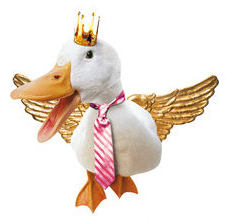 With Die Ente vom Lehel's success throughout the 1980s, Wodarz finally decided to
take a leap and take his concept on tour. In 1990, he founded the gastronomic
entertainment show Panem et Circenses ("Bread and Circuses") with the help of famed
chef Alfons Schubeck and Bernhard Paul, founder of the Roncalli Circus. Wodarz's
concept was now beyond dinner-theatre; it was dinner-theatre-circus. The show was an
immediate smash hit, touring Munich, Cologne, Hanover, Wiesbaden, Frankfurt, Barcelona,
Hamburg, Venice, and Milan.
With Die Ente vom Lehel's success throughout the 1980s, Wodarz finally decided to
take a leap and take his concept on tour. In 1990, he founded the gastronomic
entertainment show Panem et Circenses ("Bread and Circuses") with the help of famed
chef Alfons Schubeck and Bernhard Paul, founder of the Roncalli Circus. Wodarz's
concept was now beyond dinner-theatre; it was dinner-theatre-circus. The show was an
immediate smash hit, touring Munich, Cologne, Hanover, Wiesbaden, Frankfurt, Barcelona,
Hamburg, Venice, and Milan.
Heartened by the runaway success of Panem et Circenses, Wodarz decided to develop
it into an even larger production. Taking inspiration from Edward Elgar's famous
composition, Wodarz renamed the show Pomp Duck and Circumstance and, in March 1993,
revealed the rebranded production in Düsseldorf under the direction of none other than
Franco Dragone, Cirque du Soleil's most iconic director.
At this point, everything was going right for Pomp Duck and Circumstance. With
sold-out shows, a unique concept, and upwards of 300,000 European patrons applauding
the show, Hans-Peter Wodarz saw that he had a triumph on his hands - as well as a golden
opportunity. Like Guy Laliberté before him, he knew that the next step for him was to
take his concept to a brand new, uncharted market: the United States. However, for all
of Pomp Duck's wild successes in Europe in the early 1990s, it would soon falter in the
very same market that Cirque du Soleil was conquering at that time.
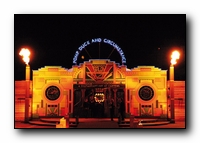
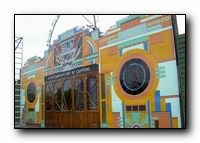
The show's 1995 tryout in New York City was, in a word, disastrous. Critics ripped
every single aspect of the show apart, leading to a poor audience turnout. But with
new investors and a concrete plan to take up residency at MGM Grand in Las Vegas for
a decade, Wodarz kept pushing for Pomp Duck's American takeover, hoping that its next
stop in Atlanta for the 1996 Olympics would fare better than the Big Apple.
It didn't. While critics were far kinder to the show in Atlanta, audiences simply
weren't interested. Audience attendance went instead to the Olympics' much cheaper
sports offerings, causing Pomp Duck to massively underperform and create a mountain
of debt for its owners. To make matters worse for Wodarz, his new partner, entrepreneur
Dieter Esch, violated the terms of their contract by hastily leaving their partnership,
and MGM soon after withdrew their $20 million investment in the show, dashing any hopes
for a Las Vegas residency. Artists went without pay, electricity was cut, and Wodarz
was left practically penniless. Pomp Duck and Circumstance's break into the American
market was, by all accounts, a colossal failure.
So then what changed? What allowed the show to get back up on its feet, become a
bigger success than ever, and continue to run for another 15 years? Enter the chic,
new Canadian circus company, Cirque du Soleil.
Wodarz returned to Europe the summer of that year, hoping to resurrect his
gastronomic entertainment concept from the dead. It was obvious from his earlier
successes that the niche humour of Pomp Duck appealed to German audiences far more
than American crowds. Clearly, Wodarz needed to return to his roots and reignite
Germany's interest in his show. Consequently, he went searching for partners to
breathe new life into the production. Recalling Cirque du Soleil from his previous
collaboration with Franco Dragone, Wodarz reached out to the company about forming
a professional relationship. Cirque agreed to a partnership, and in December 1996,
Pomp Duck and Circumstance officially joined forces with the Canadian circus giant.
Given Wodarz's precarious financial position, Cirque took on most of the financial
burden of creating the new production with a mutual understanding that their team
would have creative control of the show. Wodarz and Cirque set up a joint GmbH
("Gesellschaft mit beschränkter Haftung", a common type of limited liability company
in Germany) with equal shares in Pomp Duck. Cirque, however, took over the investment
costs in the millions, almost solely funding the 5-million German mark production
(about $13 million USD in 2020).
Once the paperwork was done, Cirque had no time to lose to prepare the show. With
Wodarz eager to return to the German market as soon as possible, Cirque now had an
extremely short 6 months to create, stage, and mount a brand-new version of Pomp Duck
and Circumstance out of their European headquarters in Amsterdam. A ragtag group of
some of Cirque's best creatives were put together, with Gilles Ste-Croix at the helm
as writer and director, René Bazinet as assistant director, Luc Lafortune as lighting
designer, and Guy Caron - back for the first time since his controversial exit from
the company in 1988 - as an artistic consultant. Some newer faces rounded out the rest
of the creative team, with Eleni Uranis - later makeup designer of ZED, KURIOS,
Amaluna, etc - as costume designer, Raffaele De Ritis as dramaturge, and Rudi
Mauser - one of the few creators from the original Pomp Duck - composing the show's live
musical score.
It was an exciting time at Cirque du Soleil. Pomp Duck and Circumstance was s
haping up to be many "firsts" for Cirque: the company's first scripted show; the
company's first dinner-theatre production; the company's first non-original show.
Cirque was running head-first into completely uncharted territory. The time and
date were set: Pomp Duck would open on June 12, 1997, in Hamburg and perform for
an ambitious 10-month run. Cirque was ready to add another jewel to their sparkling
crown of shows. But the question still remained... would this gamble pay off? And,
above all, what would this strange new show look like?
 |
POMP DUCK AND CIRCUMSTANCE - displayed in a bright blue neon archway was the show's
namesake, greeting guests as they made their way to the tent's lavish grand entrance.
But this was no ordinary blue-and-yellow grand chapiteau; this was the "Salon Zazou",
a beautiful antique 1930s spiegelzelt (mirror tent) refurbished and repurposed with
grand aplomb by Hans-Peter Wodarz for Pomp Duck. As guests approached the entranceway,
more details would come into the picture: the façade's beautiful stained glass; the
elegant waiters standing ready to welcome them into the tent; and, perhaps most
importantly, the show's motto - "A Restaurant Out of Control!" - displayed above the
doors, foreshadowing the zaniness of the next 4 hours.
That's right - four hours. Pomp Duck and Circumstance wasn't just a short,
simple sit-down-and-watch performance; it was an all-encompassing experience for the
senses meant to be enjoyed as a full-evening adventure. Once inside, guests would be
amazed by Salon Zazou's stunning interior design. At one time an ornate circular dance
hall, the space now hosted 40 tables with seats for 400 guests. The walls were covered
on all sides with 450 mirrors, giving the impression that the space was infinite in
its scope. Rather than metal poles and scaffolding, the hall stuck to the customs of
the Belgian spiegelzelt tradition by having wooden beams and canvas hold up the
structure of the tent. Finally at the top of the tent was an eloquent red and gold
ruffled canvas design surrounded by a ring of genuine stained glass.
Having feasted their eyes on Salon Zazou's grand hall, guests would then notice the
apparent lack of a stage, with tables and chairs seemingly taking up the entire space.
With the exception of a small circular stage in the centre, guests would soon discover
that the events of the show would actually occur in the aisles... and at their tables. It
was time for the eccentric characters of Pomp Duck and Circumstance to be introduced.
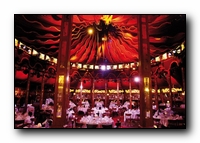
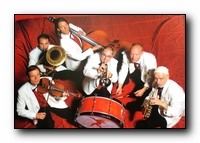
The night would start off normal enough. Guests would find their seats at their
tables and engage in small talk. The Pomp Duck Orchester would serenade the crowd,
with Scott White (electric and double-bass) leading the band alongside Achim Rothe
(trumpet), Ulrich Bartel (violin/guitar), Pavel Rendzov (drums), Carsten Netz
(saxophone), and Johannes Bahlmann (piano). 45 first-class waiters would stream in
and out of the hall, serving up dishes with meticulously choreographed precision. The
guests were experiencing fine dining at the highest level - and with tickets to the tune
of 185 marks per person ($500 USD in 2020!), one wouldn't expect anything less. But the
peace and calm of the "restaurant" would soon give way to ridiculous theatrics...
| |
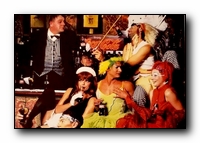
|
One by one, various characters would start entering the hall, causing trouble for
the Pomp Duck management. Some characters would complain loudly about their problems,
others would flirt with the guests (one could even say that Pomp Duck was Cirque's
first "adult show", before Zumanity). Some of the more opportunistic characters would
even go so far as to sit at guests' tables and try to order food! The formal waiters
and management would, of course, try to keep things under control by kicking out the
characters and keeping them away from their valued customers. Although this would work
temporarily, the restaurant would inevitably, as per their motto, run "out of control".
The energy of the Salon Zazou took on a soul of its own, infecting everyone in it with
the same lunacy as its zany characters. Before long, the restaurant's dignified waiters
would lose their solemnity, shedding their prim and proper façades and transforming
into snooty, defiant, and playful characters.
The lines between the characters and the restaurant staff would become blurred - who
are the clowns and who are the servers? They all became the same in the Salon Zazou.
If guests were lucky, they would get duct-taped to their chairs or be forced to dance
for their food; if they were unlucky, they would get wine spilled in their lap by a
disobedient sommelier or be placed in a boxing ring against a dishevelled-looking
character. While this may sound awful, the bizarre personages of Pomp Duck and
Circumstance were contrasted with some outstanding world-class entertainment in the
form of operatic arias, hilarious sketches, and circus disciplines that would certainly
make the whole experience worthwhile. No matter what, if you booked a visit to the
Salon Zazou, you were in for a night that you would not soon forget.
Now the question begs to be asked: who were these characters and what amazing
feats did they perform?
 |
Cirque du Soleil's version of Pomp Duck and Circumstance revolved around a
relatively loose plot, where the audience was part of a 4th wall-breaking, interactive
show about a restaurant - the "Salon Zazou" - taking on a life of its own and running out
of control, turning from a high-class eatery into a wild cabaret. An over-the-top,
madcap blend of culinary delights, comedy, and acrobatics, the show blurred the lines
between the tables and the stage, and therefore the performers and the audience.
Everything in the Salon Zazou seemed to happen by coincidence... but nothing was left
to chance.
Unlike most Cirque shows, the majority of the performance came in the characters'
interactions between both themselves and the audience. Each and every single artist
in the show played a virtuous person who toppled over the edge into excess and vice - and
with over 90 artists in the show, there are far too many characters to go into detail
about. That being said, some notable personages added a bit more spice to the Pomp
Duck pot than others:
- Madame Zazou: "Madame Zazou - the Mistress of Ceremonies - is the good soul
at Pomp. The hostess is beautiful, powerful, crazy and rich. She is allowed to do
as she pleases; and with her playfully erotic nature, she constantly conveys to
guests the feeling that they are welcome. She gives the Spiegelpalast (Palace of
Mirrors) an atmosphere that is dense, lascivious, crazy and unique, just like
Zazou herself. "You're welcome" is the message that Madame Zazou radiates with
every word, every smile and every apparently fleeting gesture."
- Maitre 'D: "At Madame Zazou's side we find Maitre 'D, her stern left hand
from Great Britain who constantly disrupts the program. However, he becomes younger
and crazier by the hour as the restaurant runs out of control."
- Madame Pierrette: "Madame Pierrette demonstrates the charm of old age. When
she serves, she forgets her age and always tries to carry too many plates. At the same
time, she has to keep an eye on her "well-bred" son Maitre 'D."
- Erich A.D. Schmeisser: "Erich A.D. Schmeisser, the fanatic taxman, is the
'enfant terrible' of the show. This financial offender, who only thinks of money, is
seeking a confession from Hans-Peter Wodarz, the restaurant owner. He wants to collect
taxes from Wodarz using all of the tricks and with the cold-hearted dedication of a
German tax investigator. But in this battle for taxes, he repeatedly runs into the
fierce resistance of the Pomp crew. They make life difficult for this civil servant
with a one-track mind. (One could surmise that Schmeisser was a not-so-subtle
reference to Wodarz's former financial partner Dieter Esch, who left him out to
dry when Pomp failed in the U.S.)
- Mimosa/The Singer: "Mimosa, the flower seller, stands for a principle
of the Pomp, namely that only those who change remain true to themselves. At the
beginning of the show, Nadya Blanchette plays the well-behaved, shy flower girl who
slowly transforms - princess-like - into a beautiful Bel Canto singer. With her
crystal-clear soprano voice, she provides magical moments of music from "O mio babino
caro" (Puccini's Gianni Schicci) to "Ach ich fühl's es ist entschwinden" (Mozart's
Magic Flute)."
- Shaman Kuaki and Sous-Chef Marcel: "The cooks are the heart and soul of
every restaurant. Chef Shaman Kuaki (a rather racially insensitive stereotype of a
Native American) and Sous-Chef Marcel (a classic French chef) work hand in hand when
it comes to adding the right spices to the show interludes. They intensify the chaos
when the show threatens to erupt and extend the menu when the pace needs to be
relaxed."
- Mrs. McNiklison: "Created by Kris Niklison, Mrs. McNiklison presented a
surprisingly funny mime sketch wherein she used the subject of her husband's death
as a means to draw attention to herself. In addition to Mrs. McNiklison, Kris Niklison
also played the blonde bombshell Ginger Kennedy, who would flirt with guests while she
delivered food to tables. (These characters were only featured in the Hamburg run in
1997 and 1998.)"
- Walter: "Walter, the caretaker, is always there where he is not needed,
but invisible when you're looking for him. Walter is just like a real caretaker,
always helping the kitchen staff and is not even afraid of a boxing match with the
"taxman", Mr. Schmeisser. (Played by Cirque veteran Gerry Regitschnig, the character
of Walter was featured starting in Düsseldorf in 1998.)"
- Daniello: "Daniello, the unskilled waiter, has all the charm of an
amateur who can't do anything right, but wants to do his best - just like real life.
Eventually, he transforms himself into an unbeatable superman. We can see a fast
career from dishwasher to superman - just like in everyday life. (Daniello was
featured starting in Düsseldorf in 1998)."
- Ruccola: "Ruccola knows how to make the blood surge in the veins of the
males in the audience. She is still waitressing when the others are already rolling
on the floor. Foreplay and afterplay are provided simultaneously with the appetizer
and the dessert. However, these cases of adultery only last a few minutes, because
nothing is so boring as the moment after it is over."
- Regine Kratzert: "Regine Kratzert not only scrapes away the dirt in this
noble restaurant but also at the ego of a macho society. This cleaning lady wants
to have things clean and warns wives against dirt, dust and grime. This low-income
woman does her profession proud by sweeping the rude Mr. Schmeisser out of the
room."
- Frédérique: "Personally testing just how far he can go is Freddy the
diva's specialty. This ballet waiter was once a great dancer and would love to
return to a large stage. Frédérique, who always has an eye on the masculine in a
man, is different from the others - a clown who playfully bills and coos during the
show."
- Anna: "A German stereotype, Anna personifies Bavarian cheerfulness in
any situation, coupled with the profundity of an experienced waitress."
Now that we know who our featured players are, what does the lineup for the
evening look like?
DISH: APPETIZER — After a number of characters have introduced themselves and
are milling about the hall, the first dish is served: Pomp Duck's famous Tomaten-
Karotten-Suppe (carrot-tomato bisque). For 400 patrons, the kitchen uses over 35 kg
(77 lbs) of carrots and 50 kg (110 lbs) of tomatoes every night!
FLASCHENXYLOPHON (Bottle Xylophone) — You will see Pavel Rendzov in your dreams,
which will be tuneful and harmonious because the man generates the richest sounds with
the world's most economical instrument. In his Flaschenkonzert (bottleconcert), Pavel
undertakes a sensitive survey of European musical history by playing dozens of famous
melodies on hundreds of bottles tuned to different musical notes. It is an honour for
the masters of the "classics" to be interpreted by him.
MUSICAL CONTORTION — Mercedes Chénard fully lives up to her profile - she is purely
erotic in all of her roles, be it as a cigarette girl, artist, singer, interpreter or
entertainer; her natural charm and her unrivalled professionalism make her a unique
artist. When she sings "Makin' Whoopee" into the microphone between the daring
hair-raising contortions and orthopedically impossible twists, you could hear a pin
drop in the tent. These rare sights must be seen to be believed. Mercedes later comes
out to perform an energetic rendition of Elvis Prestley's "Jailhouse Rock" in a full
Elvis get-up that would make even the best of impressionists jealous.
DISH: MAIN COURSE — The next meal is brought out by Pomp's waiters: a delicious
salmon and halibut lasagne.
DIABOLO — Whoever dances with the devil needs strong nerves and a firm rope.
Donald Grant maltreats the oldest juggling equipment with devilish perfection. When
he allows his wheel to glide across the rope, there is a pandemonium; tension and
relaxation alternate more quickly than the rope does.
MAGIC — If you haven't seen Nathan the Wise, then you haven't seen real magic yet.
This Russian magician has already enchanted audiences in 40 countries and has remained
true to his philosophy of life. He wants to show people what they have never seen
before and he wants to inspire the audience to view the world in a different way.
DUCK HUNT — Sous-Chef Marcel - appearing in safari gear and holding what can only
be described as a rifle made out of kitchen supplies - prompts all the characters to
participate in the "Duck Hunt" by chasing an anthropomorphic duck around the tent.
The hunt ends when the prey "ducks" into the kitchen, triggering the arrival of the
main course, which is none other than the famous Pomp Duck.
DISH: MAIN COURSE — Lead in marching order by Maitre 'D are Pomp's waiters,
bringing out 400 perfectly-prepared duck breasts. The duck is served to the tune of
none other than "Pomp and Circumstance", a march by Edward Elgar. Every night is
the "Last night of the Proms" in the Spiegelpalast.
TRAPEZE DUO — Duo Balancia rewrites acrobatic stunts under an open tent. The two
cigarette girls are not afraid to tread where angels dare not go. With their works
of art between heaven and earth, they deliberately avoid routine perfectionism. They
play with the amateurism of beginners, risk mistakes and provoke accidents - but with
constant, mature professionalism, which repeatedly shows the audience how many risks
there are when you're working without a net.
SILKS — Isabel "Beo" Da Silva brings old memories to life when she turns into
a purring cat playing with bands of silk, like Eartha Kitt, and skillfully plays on
the emotions of the audience. (Some Cirque fans may recall her memorable performance
on the Solstrom episode "Rockin' Wind" back in 2004 when she presented her impressive
silks act while singing!)
DISH: DESSERT — Dessert is always extremely important to the architects of taste.
Their sweet inspirations change with the season: ice cream, a variety of cakes and
selections of fruit. Dessert is always the mirror image of the show and continues to
seduce even the "regular guests".
AERIAL HOOP DUO — Brazilian artists Marta Chaves and Rosiris Garrido (known as
"Ouro") present an amazing act on a single aerial hoop, choreographed by Cirque's
André Simard. The duo use aesthetics and images which are often unfamiliar, working
with their own movements, transmitting sensations, emotions... A work of art, either
sweet or aggressive, sometimes spontaneous and delicate, sometimes tense and hard.
Aerial hoop was performed intermittently during Pomp Duck and Circumstance's
lifetime and would sometimes alternate with...
HAND BALANCING — Dimitri (Dmitry) Azarov shows the audience that he wants to
get to the top at all costs! He presents a world-class hand-balancing act. Technical
perfection, immense power, aesthetic fascination and the grace of a dancer coalesce
here. He reduces his individual appearances to "simple pictures" and this is the
secret of his artistry.
FINALE — The kitchen explodes. Chaos erupts... excitement, tumult and role changes
are the order of the day. The restaurant theatre is "out of control". During the
finale just before midnight, a firework of ideas and actions is kindled by all of
the participants. Artists, chefs, waiters and musicians gather in the arena to show
what Pomp really means and is. The circle closes; the show ends with an Irish folk
song - grandiose and full of energy down to the last tone.
Sometimes, a rola bola act would be performed - this rarely-seen act was performed
on occasion as a replacement for any of the main acts in the show. And of course,
throughout the show, there were many, many clown and character bits. Mrs. McNiklison
would present her mime act or Walter would pretend to box with Erich A.D. Schmeisser.
Nadya Blanchette would have several moments in the spotlight throughout the show,
singing dance numbers or operatic arias. Food would be served, guests would be tied
to their seats, wine would be spilled. By the end of every night Pomp Duck and
Circumstance was truly "out of control".
 |
So how successful was Cirque du Soleil's refreshed staging of Hans-Peter
Wodarz's brainchild of a show? Why not ask Wodarz himself...
In an interview with German newspaper Die Welt in March 2000, Wodarz touted
Pomp Duck's many triumphs. He reported that over the three previous years, the
show had seen an average audience occupancy rate of 86% (i.e. 344 of 400 seats
sold each night on average) and an annual profit of over 20 million German marks
(equal to about $60 million USD in 2020). Reviews in the press were stellar, and,
just as Wodarz had hoped, audiences from his home country flocked to see the show.
Pomp Duck ran for a whopping 10 months in Hamburg after opening in June 1997 and
then went on to play for 8-month-long runs in Düsseldorf (1998/1999) and Munich
(1999/2000). It could easily be concluded that thanks to Cirque du Soleil, Pomp
Duck and Circumstance was now more successful than it ever had been.
Thus it can only be left to speculation as to why Cirque's official involvement
with the show ended abruptly after the show's Munich run in May of 2000. Maybe
Cirque's contract with Wodarz was simply ending and they didn't renew it. Maybe
Wodarz wanted to "reclaim" his show, with Cirque having served its purpose by
revitalizing Pomp. Contrarily, maybe Cirque wanted out, for one reason or another.
There's not much information that indicates why Cirque was finished with Pomp in
2000. However, perhaps the events after the Cirque era can hint at what happened.
Although Cirque's "official" involvement with the show was from December 1996
until the end of the Munich run in May 2000, the show stayed largely the same when
it opened at its next stop in Frankfurt in August 2000. Certain elements - such as
Nadya Blanchette's singer role and the aerial hoop duo - were immediately tossed
out while others were kept. For a while. As the Frankfurt run progressed, Wodarz
slowly started bringing in new elements to the show, replacing Cirque's version
piece-by-piece. It's evident that Wodarz simply grew tired of the same old show
and wanted to refresh it (again). Then, in August 2001, an entirely re-written
version of Pomp Duck, directed by David Shiner, premiered in Berlin. The Cirque
du Soleil era of Pomp Duck and Circumstance was finally over.
 |
So what became of Pomp Duck and Circumstance after that? Well, for the most part,
the machine kept running. The show continued to be a success, touring throughout
Germany and delighting thousands of patrons. Then, in early 2006, Hans-Peter Wodarz
made the decision to part from the show. While this came as a surprise to some, the
most shocking event came in the autumn of 2007 when he partnered with the
dinner-theatre company PALAZZO, a knockoff version of Pomp Duck that began directly
competing with the show in 1998. This decision was a slap in the face to the Pomp
Duck team; a betrayal by the very creator of their show.
It was an interesting choice by Wodarz. Despite him being Pomp Duck's only
advocate when all other producers bailed on the show in the United States, it
seemed that Wodarz, too, bailed on the show just 10 years later, leaving Pomp
in the dust. Ultimately, Wodarz seemed to love the concept of Pomp Duck and
Circumstance, but not necessarily the show itself. As of May 2020, Wodarz is
still a proud producer of PALAZZO.
As for Pomp Duck, everything went downhill after Wodarz left. In 2007, its
producers made the fatal decision to move the show from its Berlin home to the
much smaller city of Stuttgart. By March 2009, the Stuttgarter Nachrichen reported
that the show would close 4 months earlier than expected, with rumours flying for
months earlier that the show was faltering and audiences not even supporting a
3-shows-per-week schedule. In November of that year, a final attempt was made to
revitalize the ailing company. A new 2-hour version directed by Arthur Castro
(with much cheaper tickets) opened on November 12 for a limited run until January
31, 2010, with hopes that audiences would prove that there was still some love
left for Pomp Duck and Circumstance.
It can only be surmised from there that the show's final attempt didn't land.
The show's website, still available today at
pompduck.de, remains
un-updated since October 2010 with optimistic press releases
of what's to come - an ironic relic of the show's final resting place.
Wodarz, then and now, rarely mentions Cirque in his interviews. Occasionally
he'll mention in passing that "at one time" Cirque was a part owner in the company.
Similarly, the Pomp Duck website rarely mentioned Cirque throughout the years (the
website as it is today only mentions the "help of friends from the Canadian Cirque
du Soleil" once). It's as if they consider Cirque to be just a small blip in their
history; that they were just investors that helped out the company rather a group
of creatives who practically rebuilt the show from the ground up.
Cirque likewise rarely comments on Pomp. The show is sometimes placed amongst
their historical list of shows, mentioned in passing in a creative team member's
biography, or, in the best-case scenario, given a sentence of description in an
old programme book. Pomp Duck and Circumstance simply seems to be a statistic for
Cirque - just another card in their collection of shows, rarely mentioned alongside
the company's failures like Banana Shpeel, Viva Elvis, and Criss Angel Believe.
But does Pomp Duck and Circumstance truly deserve to be sidelined with Cirque's
forgotten blunders? Can the show truly be summed up as a "success" or "failure"?
It depends on how you look at it.
Yes, more than 1.5 million people saw Pomp Duck from its 1990 inception up to
its final legs in 2010. However, most of that attendance was only in the few years
when it was truly successful.
Yes, the show was a brand-new concept that revolutionized dinner-theatre
entertainment. However, its demise was hastened by a competitor that took
advantage of that very concept.
Yes, many audiences and critics adored the show. However, just as many
people despised the show with a burning passion.
It seems that Pomp Duck and Circumstance's entire existence was one big
contradiction. However, I personally think that the one era in Pomp's lifetime
that was truly successful on all accounts was the Cirque du Soleil era. A
critical and commercial hit, Cirque du Soleil's Pomp Duck was a mutualistic
relationship that ultimately allowed each company to grow and prosper out of
an unexpected collaboration. For Wodarz, Cirque brought his show back to life
and expanded his artistic license, allowing him to thrive more than ever. For
Cirque, Pomp Duck presented a challenge that forced them to expand outside their
comfort zone, allowing them to experiment with risky elements that would later
lay the groundwork for Zumanity, Solstrom, JOYÀ, and all of their collaborative
shows such as LOVE and Criss Angel Believe.
Pomp Duck and Circumstance is an odd detour in the decades-long history of
Cirque du Soleil. Had Cirque not done such a good job at hiding Pomp, perhaps
we would know more about this experiment - this strange, but ultimately successful,
experiment. And though we'll never truly know what the show was like, perhaps we
can take some solace in knowing that had it not been for this collaboration, we
would've never had other experiments like Zumanity and LOVE. And Cirque du Soleil,
ever the risk-taker, would certainly not be where it is now.
"And last, but not least, is Pomp Duck and Circumstance..."
Researched and Written by Henry Peirson
|
|
|
|
|
|

![]()




